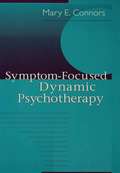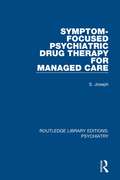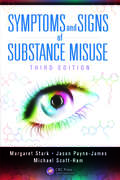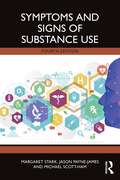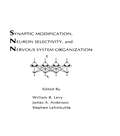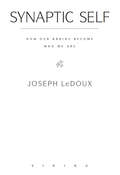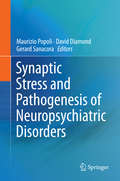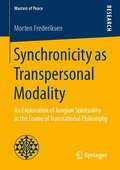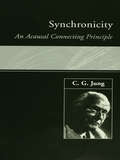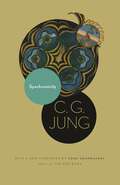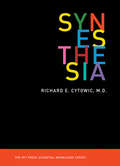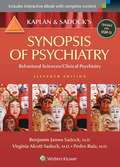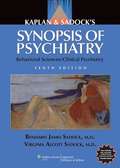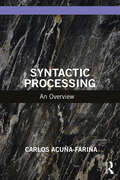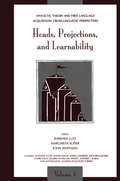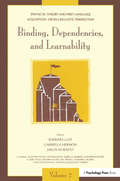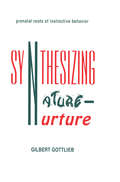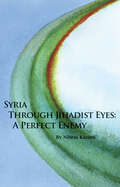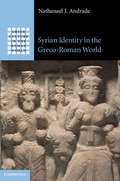- Table View
- List View
Symptom-Focused Dynamic Psychotherapy
by Mary E. ConnorsTraditionally, psychoanalytically oriented clinicians have eschewed a direct focus on symptoms, viewing it as superficial turning away from underlying psychopathology. But this assumption is an artifact of a dated classical approach; it should be reexamined in the light of contemporary relational thinking. So argues Mary Connors in Symptom-Focused Dynamic Psychotherapy, an integrative project that describes cognitive-behavioral techniques that have been demonstrated to be empirically effective and may be productively assimilated into dynamic psychotherapy.What is the warrant for symptom-focused interventions in psychodynamic treatment? Connors argues that the deleterious impact of symptoms on the patient's physical and emotional well being often impedes psychodynamic engagement. Symptoms associated with addictive disorders, eating disorders, OCD, and posttraumatic stress receive special attention. With patients suffering from these and other symptoms, Connors finds, specific cognitive-behavior techniques may relieve symptomatic distress and facilitate a psychodynamic treatment process, with its attentiveness to the therapeutic relationship and the analysis of transference-countertransference. Connors' model of integrative psychotherapy, which makes cognitive-behavioral techniques responsive to a comprehensive understanding of symptom etiology, offers a balanced perspective that attends to the relational embeddedness of symptoms without skirting the therapeutic obligation to alleviate symptomatic distress. In fact, Connors shows, active techniques of symptom management are frequently facilitative of treatment goals formulated in terms of relational psychoanalysis, self psychology, intersubjectivity theory, and attachment research. A discerning effort to enrich psychodynamic treatment without subverting its conceptual ground, Symptom-Focused Dynamic Psychotherapy is a bracing antidote to the timeworn mindset that makes a virtue of symptomatic suffering.
Symptom-Focused Psychiatric Drug Therapy for Managed Care (Routledge Library Editions: Psychiatry #12)
by S. JosephOriginally published in 1997, this title describes therapeutic applications of simple to complex combinations of medications to treat common psychiatric disorders among adults. Dr Joseph discusses practical, clinical guidelines that both the beginner and experienced practitioner will find useful. The 100 psychopharmacological cases presented in Part 2 illustrate the application of the diagnostic and treatment concepts described in Part 1. The cases are grouped into simple, moderately complex, and complex cases. The clinical cases, besides evoking a "hands-on" feeling which facilitates learning, can be used to compare your current treatment approach to that of an experienced and highly successful practicing psychiatrist.A vital addition to every psychiatrist's library, this guidebook is indispensable to those seeking a better understanding of patients’ problems from a psychopharmacological perspective that is both practical and effective. Numerous and varied clinical presentations are reduced to treatable symptoms so that even physicians who lack experience with a specific medication or combination of medications will be able to use these interventions successfully. For each of the 100 clinical cases presented in the book, the clinical history, treatment course, medication doses, and treatment outcome are carefully detailed in a step-by-step analysis.Unique features of this book that will be useful to psychiatrists, primary care physicians, and all mental health clinicians include: its symptom-focused approach; its discussion of modern rational polypharmacy; specific dosing guidelines; office management of severe disorders; treatment of special patients, such as celebrities and other doctors; clinical cases; and sample answers to common questions asked by patients.Psychiatrists, psychiatric residents, psychotherapists, psychiatric nurses, and other physicians will find thorough and clear explanations of treatment strategies and their nuances in this volume. Physicians interested in learning balanced and rational use of various psychotropic medication combinations will find themselves turning to this book again and again as they strive to alleviate psychiatric symptoms in patients and exercise techniques that minimize or avoid inpatient psychiatric hospitalization.
Symptoms and Signs of Substance Misuse
by Jason Payne-James Margaret Stark Michael Scott-HamThe misuse of both legally prescribed and illegally supplied drugs is now so widespread that it affects, either directly or indirectly, a high proportion of the population, impacting many areas of daily life. There are few countries that are not touched by some aspect of substance misuse and the consequences for individuals, families and the wider
Symptoms and Signs of Substance Use
by Jason Payne-James Margaret Stark Michael Scott-HamThis fourth edition of Symptoms and Signs of Substance Use has been thoroughly updated and revised, continuing to provide trusted information from leading experts.There are few countries that are not touched by some aspect of substance misuse and the consequences for individuals, families and the wider community can be devastating. This edition includes new legislation, in relation to cannabis and novel psychoactive substances (NPS), as well as the following features: basic principles of treatment for the most commonly encountered substances—from tobacco and alcohol to cocaine and heroin, as well as 'designer' drugs, the legal aspects of substance use highlighted throughout, a convenient A-Z format helps the reader find information at a glance, a bibliography directs the reader to more authoritative information about each substance and review questions at the end of parts I and II help to embed learning. With specialist information clearly explained along with a full glossary, this book is essential for all health professionals and others needing a concise and up-to-date overview of the signs and symptoms of substance use, as well as the management and treatment options available.Those working in primary and secondary care, including general forensic medicine, emergency medicine, psychiatry, sexual offence medicine, and general practice, will find this text invaluable. This book is also an excellent resource for police officers, as well as a quick reference guide for forensic scientists, toxicologists, and postgraduate students in forensic medicine courses.
Synaesthesia and Individual Differences
by Aleksandra Maria RogowskaSynaesthesia is a fascinating cognitive phenomenon where one type of stimulation evokes the sensation of another. For example, synaesthetes might perceive colours when listening to music, or tastes in the mouth when reading words. This book provides an insight into the idiosyncratic nature of synaesthesia by exploring its relationships with other dimensions of individual differences. Many characteristics of linguistic-colour synaesthetes are covered including personality, temperament, intelligence, creativity, emotionality, attention, memory, imagination, colour perception, body lateralization and gender. Aleksandra Rogowska proposes that linguistic-colour synaesthesia can be considered as an abstract form of a continuous variable in the broader context of cross- and intra-modal associations. There has been a resurgence of interest in synaesthesia and this book will appeal to students and scientists of psychology, cognitive science and social science, and to those who are fascinated by unusual states of mind.
Synaptic Modification, Neuron Selectivity, and Nervous System Organization
by William B. Levy, James A. Anderson and Stephen LehmkuhleFirst published in 1985. Routledge is an imprint of Taylor & Francis, an informa company.
Synaptic Self: How Our Brains Become Who We Are
by Joseph LedouxIn 1996 Joseph LeDoux's The Emotional Brain presented a revelatory examination of the biological bases of our emotions and memories. Now, the world-renowned expert on the brain has produced with a groundbreaking work that tells a more profound story: how the little spaces between the neurons—the brain's synapses—are the channels through which we think, act, imagine, feel, and remember. Synapses encode the essence of personality, enabling each of us to function as a distinctive, integrated individual from moment to moment. Exploring the functioning of memory, the synaptic basis of mental illness and drug addiction, and the mechanism of self-awareness, Synaptic Self is a provocative and mind-expanding work that is destined to become a classic. .
Synaptic Stress and Pathogenesis of Neuropsychiatric Disorders
by David Diamond Maurizio Popoli Gerard SanacoraRecent studies show that changes in Glutamate/GABA synapses and related pathways may determine whether the synaptic plasticity that occurs as a response to stress is adaptive or maladaptive. Findings have shed new light on the mechanisms that determine the effects of stress on cognitive and affective function. Researchers have brought a wide range of techniques to bear on the study of this problem, including cutting-edge live imaging techniques, electrophysiology, glutamate release from isolated live synaptic terminals, development of transgenic and animal models and new behavioral methods. This book provides an overview of these recent findings and of the techniques used as well as a discussion of how the molecular, cellular, and functional effects of stress may trigger or precipitate neuropsychiatric disorders such as depression, schizophrenia, anxiety and PTSD.
Synchronicity as Transpersonal Modality: An Exploration of Jungian Spirituality in the Frame of Transrational Philosophy (Masters Of Peace Series)
by Morten FrederiksenThe author explores Carl Gustav Jung’s elusive notion of synchronicity from a transrational perspective and relates synchronicity to the transpersonality of the "All-One". This is done by expanding the content and meaning of Wolfgang Dietrich´s layers of Elicitive Conflict Mapping (ECM) through re-relating them to Ken Wilber´s model of the structures of consciousness; with synchronicity as the literal connecting principle. The result, then, is an expanded notion of the transrational peace philosophy which includes Wilber´s model of stages shorn of its evolutionary slant and fathoms synchronicity in its theoretical outlook and practical application.
Synchronicity: An Acausal Connecting Principle (Jung Extracts Ser. #598)
by C. G. JungTo Jung, synchonicity is a meaningful coincidence in time, a psychic factor which is independant of space and time. This revolutionary concept of synchronicity both challenges and complements the physicist's classical view of casualty. It also forces is to a basic reconsideration of the meaning of chance, probability, coincidence and the singular events in our lives.
Synchronicity: An Acausal Connecting Principle. (From Vol. 8. of the Collected Works of C. G. Jung) (Jung Extracts #30)
by C. G. JungJung was intrigued from early in his career with coincidences, especially those surprising juxtapositions that scientific rationality could not adequately explain. He discussed these ideas with Albert Einstein before World War I, but first used the term "synchronicity" in a 1930 lecture, in reference to the unusual psychological insights generated from consulting the I Ching. A long correspondence and friendship with the Nobel Prize-winning physicist Wolfgang Pauli stimulated a final, mature statement of Jung's thinking on synchronicity, originally published in 1952 and reproduced here. Together with a wealth of historical and contemporary material, this essay describes an astrological experiment Jung conducted to test his theory. Synchronicity reveals the full extent of Jung's research into a wide range of psychic phenomena. This paperback edition of Jung's classic work includes a new foreword by Sonu Shamdasani, Philemon Professor of Jung History at University College London.
Synergy: The Healing Energy Guiding Stepped Care 2.0
by Peter Cornish Gillian BerrySynergy: The Healing Energy Guiding Stepped Care 2.0 is a hybrid text that explores the theory and practice of synergy as it relates to the Stepped Care 2.0 (SC2.0) model for mental health care. Building on the previous volumes in this series, Stepped Care 2.0: A Paradigm Shift in Mental Health Care, and, Stepped Care 2.0: The Power of Conundrums, this third book consists of a series of essays on synergy, the philosophical idea undergirding SC2.0. Drawing on a wide range of tools from the social sciences and humanities, these essays build an argument for why a holistic and restorative approach to mental health care should incorporate synergistic perspectives and practices arising from global traditions of Indigenous psychology. By blending theory, storytelling, and academic analysis, this book provides an answer to the questions raised in the previous volumes. Using what the editors identify as the Strands of Synergy, it also offers guidance for practitioners seeking to incorporate synergy into their own practice, both in the context of the SC2.0 model, and in the clinical world more generally.
Synesthesia (The MIT Press Essential Knowledge Series)
by Richard E. CytowicAn accessible, concise primer on the neurological trait of synesthesia—vividly felt sensory couplings—by a founder of the field. One in twenty-three people carry the genes for the synesthesia. Not a disorder but a neurological trait—like perfect pitch—synesthesia creates vividly felt cross-sensory couplings. A synesthete might hear a voice and at the same time see it as a color or shape, taste its distinctive flavor, or feel it as a physical touch. In this volume in the MIT Press Essential Knowledge series, Richard Cytowic, the expert who returned synesthesia to mainstream science after decades of oblivion, offers a concise, accessible primer on this fascinating human experience. Cytowic explains that synesthesia's most frequent manifestation is seeing days of the week as colored, followed by sensing letters, numerals, and punctuation marks in different hues even when printed in black. Other manifestations include tasting food in shapes, seeing music in moving colors, and mapping numbers and other sequences spatially. One synesthete declares, “Chocolate smells pink and sparkly”; another invents a dish (chicken, vanilla ice cream, and orange juice concentrate) that tastes intensely blue. Cytowic, who in the 1980s revived scientific interest in synesthesia, sees it now understood as a spectrum, an umbrella term that covers five clusters of outwardly felt couplings that can occur via several pathways. Yet synesthetic or not, each brain uniquely filters what it perceives. Cytowic reminds us that each individual's perspective on the world is thoroughly subjective.
Synesthesia: A Union of the Senses
by Richard E. CytowicA detailed study of synesthesia, an involuntary joining of the senses in which information from one sense joins a perception from another
Synopsis Of Psychiatry: Behavioral Sciences/Clinical Psychiatry
by Pedro Ruiz Virginia A. Sadock Benjamin James SadockThe new and thoroughly updated 11th edition of Kaplan and Sadock's Synopsis of Psychiatry: Behavioral Sciences/Clinical Psychiatry is a complete overview of the entire field of psychiatry for clinicians, residents, students, and all others who provide mental health care. In this best-selling textbook in psychiatry for over 40 years, the reader will find a thorough discussion of both the behavioral sciences and clinical psychiatry. The 11th edition integrates all the DSM-5 criteria and provides a detailed and comprehensive overview of treatment methods for every known mental disorder. The 11th edition is set apart from any other reference you have and includes: DSM-5 diagnostic tables on every major psychiatric disorder. A psychopharmacology section organized according to mechanisms of action and updated to include all of the new drugs including those in preparation. Extensive use of case studies and illustrations to enhance the learning experience. The most current treatment methods including a description of all newly introduced psychotherapeutic techniques. A completely revised section on neurocognitive disorders organized along the DSM-5 model. An updated and expanded section on child psychiatry; now includes a guide to diagnosis and treatment of autism spectrum disorder and other disorders of childhood. A fully searchable eBook, bundled with the print. This publication is included on the ANCC: American Nurses Credentialing Center's reference list. The Synopsis of Psychiatry has been the leading clinical psychiatric resource for psychiatrists both in the US and around the world. It has the reputation of being an independent, accurate, reliable and objective compendium of new events in the field of psychiatry. Now in its 11th edition, the tradition continues, both in print and digital formats--from the authorities you can trust.
Synopsis of Psychiatry: Behavioral Sciences/Clinical Psychiatry (Tenth Edition)
by Benjamin J. Sadock Virginia A. SadockThe best-selling general psychiatry text since 1972, Kaplan and Sadock's Synopsis of Psychiatry is now in its thoroughly updated Tenth Edition. This complete, concise overview of the entire field of psychiatry is a staple board review text for psychiatry residents and is popular with a broad range of students in medicine, clinical psychology, social work, nursing, and occupational therapy, as well as practitioners in all these areas. The book is DSM-IV-TR compatible and replete with case studies and tables, including ICD-10 diagnostic coding tables. You will also receive access to the complete, fully searchable online text, an online test bank of approximately 100 multiple-choice questions and full answers, and an online image bank.
Syntactic Islands
by Cedric BoeckxThe phenomenon of the syntactic 'island' – a clause or structure from which a word cannot be moved – is central to research and study in syntactic theory. This book provides a comprehensive overview of syntactic islands. What are they? How do they arise? Why do they exist? Cedric Boeckx discusses the pros and cons of all the major generative accounts of island effects, and focuses the discussion on whether islands are narrowly syntactic effects, are due to interface factors or are 'merely' performance effects. Thanks to the diversity of island effects, readers are given a unique opportunity to familiarize themselves with all the major research styles and types of analysis in theoretical linguistics and have the chance to reflect on the theoretical implications of concrete natural language examples, allowing them to develop their own synthesis.
Syntactic Processing: An Overview
by Carlos Acuña-FariñaThis book provides an overview of the structures, topics and main theories of syntactic processing. It covers the last 40 years of sentence-level psycholinguistic research and debates and makes it accessible to both theoretical linguists and experimental psychologists. Tying linguistically relevant issues to psycholinguistic theory, this book: Covers the processing of the grammatical phenomena adjunction, agreement and gap filling and discusses the relationship between grammars and parsers Discusses experimental work and theories, demonstrating how psychologists have made real strides in understanding language and how studying the processing of syntactic structure is the same as studying the nature of language Explores the key theories of psycholinguistics, including recent developments Explains the different methodologies of sentence processing, such as eye-tracking and electroencephalography Bridging the gap between psycholinguistic research and the study of language, this book is essential reading for advanced students and scholars of linguistics and experimental psycholinguistics as well as cognitive science and psychology.
Syntactic Theory and First Language Acquisition: Cross-linguistic Perspectives -- Volume 1: Heads, Projections, and Learnability -- Volume 2: Binding, Dependencies, and Learnability
by John Whitman Claire Foley Suzanne Flynn Barbara Lust Margarita Suñer Shyam Kapur Isabella Barbier Katharina Boser Zelmira Nuñez del Prado Edward J. Rubin Lynn Santelmann Almeida Jacqueline ToribioUniversal Grammar (UG) is a theory of both the fundamental principles for all possible languages and the language faculty in the "initial state" of the human organism. These two volumes approach the study of UG by joint, tightly linked studies of both linguistic theory and human competence for language acquisition. In particular, the volumes collect comparable studies across a number of different languages, carefully analyzed by a wide range of international scholars. The issues surrounding cross-linguistic variation in "Heads, Projections, and Learnability" (Volume 1) and in "Binding, Dependencies, and Learnability" (Volume 2) are arguably the most fundamental in UG. How can principles of grammar be learned by general learning theory? What is biologically programmed in the human species in order to guarantee their learnability? What is the true linguistic representation for these areas of language knowledge? What universals exist across languages? The two volumes summarize the most critical current proposals in each area, and offer both theoretical and empirical evidence bearing on them. Research on first language acquisition and formal learnability theory is placed at the center of debates relative to linguistic theory in each area. The convergence of research across several different disciplines -- linguistics, developmental psychology, and computer science -- represented in these volumes provides a paradigm example of cognitive science.
Syntactic Theory and First Language Acquisition: Cross-linguistic Perspectives -- Volume 1: Heads, Projections, and Learnability -- Volume 2: Binding, Dependencies, and Learnability
by Claire Foley Suzanne Flynn Jaklin Kornfilt Barbara Lust Shyam Kapur Isabella Barbier Katharina Boser Zelmira Nuñez del Prado Edward J. Rubin Lynn Santelmann Gabriella Hermon Jacqueline ToribioUniversal Grammar (UG) is a theory of both the fundamental principles for all possible languages and the language faculty in the "initial state" of the human organism. These two volumes approach the study of UG by joint, tightly linked studies of both linguistic theory and human competence for language acquisition. In particular, the volumes collect comparable studies across a number of different languages, carefully analyzed by a wide range of international scholars. The issues surrounding cross-linguistic variation in "Heads, Projections, and Learnability" (Volume 1) and in "Binding, Dependencies, and Learnability" (Volume 2) are arguably the most fundamental in UG. How can principles of grammar be learned by general learning theory? What is biologically programmed in the human species in order to guarantee their learnability? What is the true linguistic representation for these areas of language knowledge? What universals exist across languages? The two volumes summarize the most critical current proposals in each area, and offer both theoretical and empirical evidence bearing on them. Research on first language acquisition and formal learnability theory is placed at the center of debates relative to linguistic theory in each area. The convergence of research across several different disciplines -- linguistics, developmental psychology, and computer science -- represented in these volumes provides a paradigm example of cognitive science.
Syntax
by Robert FreidinSyntax: Basic Concepts and Applications provides a systematic introduction to core topics in syntax, focusing on how the basic concepts apply in the analysis of sentences. Assuming no background in linguistic analysis, the book gives students a working knowledge of syntactic analysis from a minimalist perspective. Step by step it explains the fundamentals of phrase structure, movement and deletion. Well-placed exercises throughout reinforce and extend the concepts and analyses presented in the text, allowing readers to gain understanding of progressively complex issues at a comfortable pace. Much of the data comes from English, but crucial examples are also drawn from a range of other languages, including Russian, Chinese, Japanese, French, Italian, Spanish, Irish, Welsh and Greek.
Syntax: A Generative Introduction
by Andrew CarnieAndrew Carnie's bestselling textbook on syntax has guided thousands of students through the discipline of theoretical syntax; retaining its popularity due to its combination of straightforward language, comprehensive coverage, and numerous exercises.
Synthesizing Nature-nurture: Prenatal Roots of Instinctive Behavior (Distinguished Lecture Series)
by Gilbert GottliebThis volume provides a primarily nontechnical summary of experimental and theoretical work conducted over the course of 35 years which resulted in a developmental framework capable of integrating causal influences at the genetic, neural, behavioral, and ecological levels of analysis. It describes novel solutions to the nature-nurture problem at both the empirical and theoretical levels. Following field observations, laboratory experiments led to the discovery of the nonobvious prenatal experiential basis of instinctive behavior in two species--ground-nesting mallard ducklings and hole-nesting wood ducklings. This work also describes the experiences that lead to the rigid canalization of behavioral development as well as the social and sensory experiences that favor the continuance of flexibility. The author also describes in detail a developmental psychobiological systems view that supports a behaviorally and psychologically mediated pathway to evolutionary change in humans and other species. Written in a way that is readable to even the nonspecialist, the text is accompanied by numerous photographs that illuminate and add personal meaning to the written words. Readers will be engaged by the emphasis on the human aspect of the scientific enterprise.
Syria through Jihadist Eyes: A Perfect Enemy
by Nibras KazimiWith field notes accumulated in a Syrian environment not generally hospitable to research and inquiry, Nibras Kazimi provides a unique view of the Syrian regime and its base at home, filling a void in our understanding of the intelligence barons and soldiers who run that country. He offers a look at the tactical, propagandists and strategic ingredients required, in jihadist eyes, for a successful jihad—and whether those ingredients are available in Syria.
Syrian identity in the Greco-Roman world (Greek Culture In The Roman World Ser.)
by Nathanael J. AndradeBy engaging with recent developments in the study of empires, this book examines how inhabitants of Roman imperial Syria reinvented expressions and experiences of Greek, Roman and Syrian identification. It demonstrates how the organization of Greek communities and a peer polity network extending citizenship to ethnic Syrians generated new semiotic frameworks for the performance of Greekness and Syrianness. Within these, Syria's inhabitants reoriented and interwove idioms of diverse cultural origins, including those from the Near East, to express Greek, Roman and Syrian identifications in innovative and complex ways. While exploring a vast array of written and material sources, the book thus posits that Greekness and Syrianness were constantly shifting and transforming categories, and it critiques many assumptions that govern how scholars of antiquity often conceive of Roman imperial Greek identity, ethnicity and culture in the Roman Near East, and processes of 'hybridity' or similar concepts.
